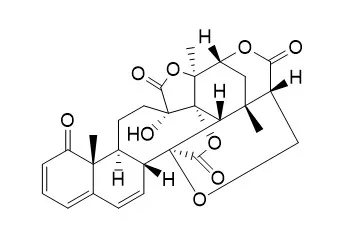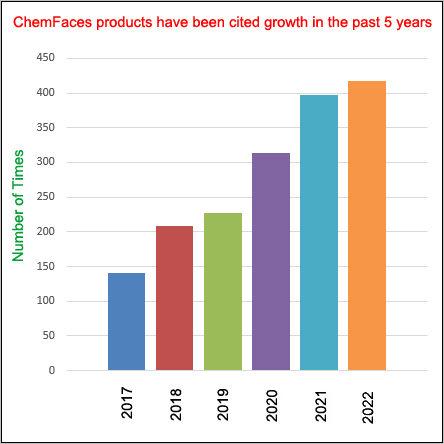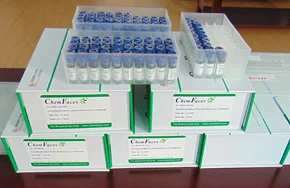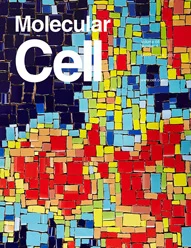| In vitro: |
| J Sep Sci . 2018 Apr;41(8):1781-1790. | | Simultaneous pharmacokinetics and stability studies of physalins in rat plasma and intestinal bacteria culture media using liquid chromatography with mass spectrometry[Pubmed: 29331063] | | Physalins are the major steroidal constituent of Physalis plants and display a range of biological activities. For this study, a rapid and sensitive high-performance liquid chromatography with triple quadrupole mass spectrometry method was developed for the simultaneous quantification of six physalins. Specifically, it was for the quantification of physalin A, physalin B, physalin D, physalin G, 4,7-Didehydroneophysalin B, and isophysalin B in rat plasma and rat intestinal bacteria. After a solid-phase extraction, analytes and internal standards (prednisolone) were separated on a Shield reverse-phase C18 column (measuring 3 mm × 150 mm with an internal diameter of 3.5 μm) and determined using multiple reactions in a monitoring mode with a positive-ion electrospray ionization source. The mobile phase was a mixture of 0.1% formic acid in water (A) and acetonitrile (B) and was used at a flow rate of 0.6 mL/min. The intra- and interday precisions were within 15% with accuracies ranging from 86.2 to 114%. The method was validated and successfully applied to pharmacokinetics and stability studies of six physalins in rat plasma and rat intestinal bacteria, respectively. The results showed that physalin B and isophysalin B could not be absorbed by rats, and rat intestinal bacteria could quickly transform physalins. | | Phytochemistry Volume 34, Issue 2, September 1993, Pages 529-533 | | Physalin and neophysalins from Physalis alkekengi var. francheti and their differentiation inducing activity[Reference: WebLink] | | A methanol extract of Physalis alkekengi var. francheti showed a potent cell differentiation inducing activity toward mouse myeloid leukemia cell line (M1 cells). From the extract, a new physalin and two new neophysalins, 25,27-dihydro-4,7-didehydro-7-deoxyneophysalin A and 4,7-Didehydroneophysalin B, were isolated along with physalin A, L and isophysalin B. The structures of physalins and neophysalins were determined by means of NMR, UV, IR and mass spectra. Of these compounds, physalin A showed potent cell differentiation inducing activity. |
|






 Cell. 2018 Jan 11;172(1-2):249-261.e12. doi: 10.1016/j.cell.2017.12.019.IF=36.216(2019)
Cell. 2018 Jan 11;172(1-2):249-261.e12. doi: 10.1016/j.cell.2017.12.019.IF=36.216(2019) Cell Metab. 2020 Mar 3;31(3):534-548.e5. doi: 10.1016/j.cmet.2020.01.002.IF=22.415(2019)
Cell Metab. 2020 Mar 3;31(3):534-548.e5. doi: 10.1016/j.cmet.2020.01.002.IF=22.415(2019) Mol Cell. 2017 Nov 16;68(4):673-685.e6. doi: 10.1016/j.molcel.2017.10.022.IF=14.548(2019)
Mol Cell. 2017 Nov 16;68(4):673-685.e6. doi: 10.1016/j.molcel.2017.10.022.IF=14.548(2019)